Elevate Your Brand’s Social Media Presence Without Blowing Your Budget
Do you want to boost your Brand’s Social Media Presence? You don’t need big budgets for ads or influencer collaborations. Check out how you can get started with a small budget.

It is far more difficult to do great social media for a brand than people think. It is an acrobatic walk on a line that is very slippery, and there are constant wind rushes that threaten to knock you off.
It is particularly difficult to ensure a significant social media presence for your brand on a limited budget. And let’s be honest, most people tasked with handling brands’ social media presence don’t exactly have money to waste.
So, what can you do when you don’t have the budget for paid social ads, influencers, and other such tactics?
Quite a bit, it turns out.
Offer Social Customer Service
Smaller brands, those with limited social media budgets, fight with the weapons they have. Whereas they cannot compete with their larger competitors in terms of budgets, pricing, discounts, and shipping prices/times, there are areas where you can put up a fight. We’re talking about providing non-standard customer service on social media.
Most people who’ve been interested in branded social media for more than five years will remember the fantastic exchange from 2016 between Skyscanner and one of their users.
Namely, the user in question was informed that one of his layovers will last for 413,786 hours, or roughly, 47 years.
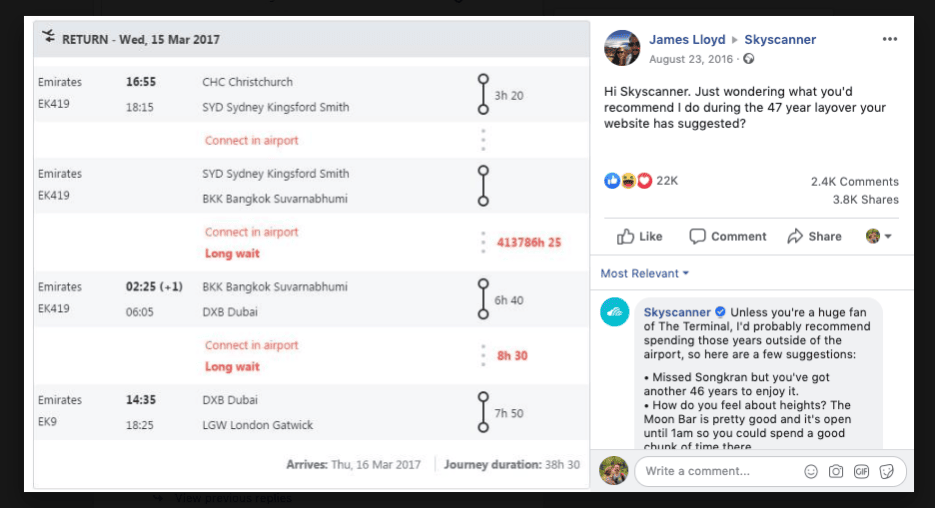
Obviously a glitch.
And where some social media customer support people would simply apologize for the issue with a standard template, Jen from Skyscanner became a legend by suggesting a few things that would shorten the user’s waiting time.

Not only did this exchange go viral, but people were publicly saying how Jen’s response will be directly responsible for them becoming users.

The best thing about this whole exchange, and numerous other examples, is that it costs nothing (or very little in some cases) to brighten someone’s day and provide social media customer care that will have people praising your brand.
What Can You Do to Improve Your Customer Service with Socials?
Of course, winging it and hoping you’ll do well is not enough. Your social media customer service needs to be well-structured, monitored, measured, and modified – even if your goal is to do it super-breezy. It needs to fit perfectly in the customer journey.
It would require an entire article to cover everything that you will want to do, but here are some of the basics that you can’t neglect:
- Choose the right channels. Not all brands’ customers are predominantly on the same social platform. If your customers are mostly on Facebook, you will put the brunt of your efforts there.
- Establish messaging guidelines. Your social media customer care needs to be consistent and appropriate. This is not saying that you cannot joke or freestyle, but it is better to have some guidelines on what is acceptable and what is not.
- Set up monitoring. Not everyone who mentions your brand on social media will necessarily tag you. This is why it is important to do this “manually” and make sure that all mentions are covered (and, if appropriate, answered).
- Set up priorities. Not all inquiries and mentions will be equally important. Some of them can wait; others cannot (like people experiencing issues with your product/service).
- Measure. Measure the frequency, the sentiment, and any trends that you notice. Use this data to figure out new ways to improve.
Understand Your Audience
It is so easy to spread yourself too thin on social media – both when it comes to all the various platforms and when it comes to the content you will be sharing.
It is really Marketing 101:
- Know who your target audience is
- Know where to find them
- Know what they are interested in
- Know how to serve it to them
Market research and segmentation is a science that takes years to master. However, there are some basics that every brand can do by researching their current customers and people who engage with your brand on social media.
Among the things that you will want to pinpoint is your audience’s age bracket, location, living standard, phase of life (teens, students, parents, elderly, etc.), interests, challenges, etc.
The essential thing here is to do research and not just presume things.
Take Bay Alarm Medical as an example. They sell emergency alarms for the elderly. You’d think they have no place on social media at all, let alone on Instagram.
Right?
Well… wrong.
They understand that their target audience is not actually the elderly who will use the product but their children and grandchildren who are concerned about them and wish them to be safe. They understand that Instagram is the perfect place to share the personal stories of their current users (and their children, grandchildren, caregivers, etc.).
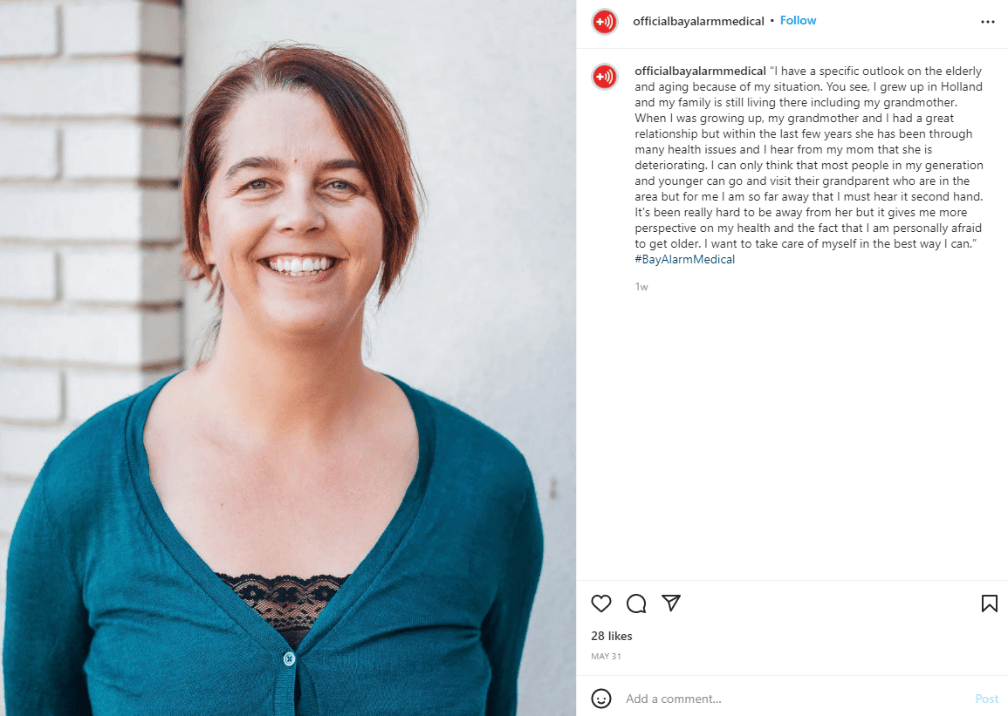
They didn’t make any assumptions. They did their research.
Reaching out on the Right Platform
Finding the right place to reach your target audience is just as important as identifying it precisely. Simply knowing where people hang out doesn’t cut it. Even if it did, the mere ratio of people’s usage of a certain social media network and their likelihood to follow brands on that network is enough to confuse you. Sprout Social did research on this, and here’s what they found out:
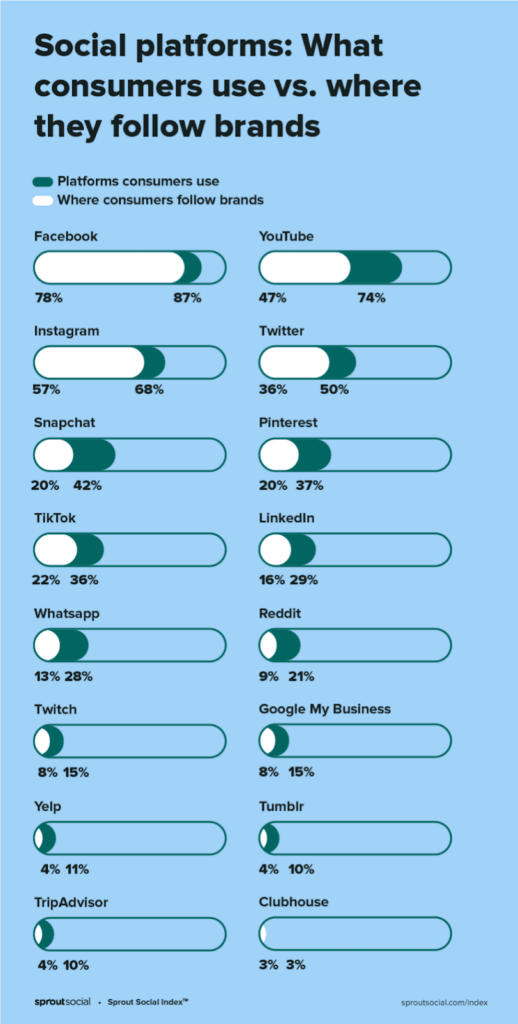
As you can see, people are far less likely to follow a brand on YouTube than they are on Instagram, even though YouTube has a larger number of users overall. When you add to that the different industries, demographics, and everything else that affects your chances of success on a certain social media network, things get very complicated indeed. In other words, there’s a lot of work to be done, including testing.
Analyze what your competitors are doing, investigate your own sources of traffic, check out the statistics for different industries and demographics, and you will start to get the picture.
Unveiling Audience Interests and Preferences
You can also expect to work just as hard on discovering their interests and thinking of the best ways to convey your message to them.
A great example to learn from is Tourism Australia (of course, they probably had a massive budget).
For instance, they discovered that their audience included people who prefer longer trips to faraway locations and who want gastronomic, wildlife, nature, and coastal experiences. Through more research, they discovered that their audience seeks local experiences and wants to learn about the world. They went so deep in their market research that they analyzed when their target audience is likely to book their trips.

You probably won’t have the resources for all of that, but there are still some things you can try.
Be Smart with Your Content
Great content can be a spectacular tool for brands that have a limited budget. After all, just because a big company has money to waste, it does not mean that a single writer or video producer working for a smaller brand cannot come up with superior content.
Unfortunately, even when they start producing truly premium content, smaller brands often don’t quite know what to do with it. They know it is great content, and they believe people will eventually stumble upon it. By the time they realize this is not the case, it’s too late.
This is why it’s important for smaller brands to be extra smart with their content and do everything in their power to put it in front of as many eyes as they can. Social media is the perfect channel. And the best thing is that it works both ways. Smart social media management means better visibility of great content, and great content means better social presence – a social presence that someone will actually engage with.
Skillcrush, an online coding school, has mastered this. Their content strategy is extremely well-thought-out, covering subjects that are very specifically targeted at their audience in great detail.
For example, you may not be that familiar with the concept of coding bootcamps, but for someone who is learning how to code, they are a very interesting prospect. Skillcrush first publishes an incredibly researched article on the subject, and then they let their Twitter account work it hard. They write the kind of content that will also be interesting to specific demographics, knowing that Twitter will pick it up naturally. Their article on ageism in tech is a great example.
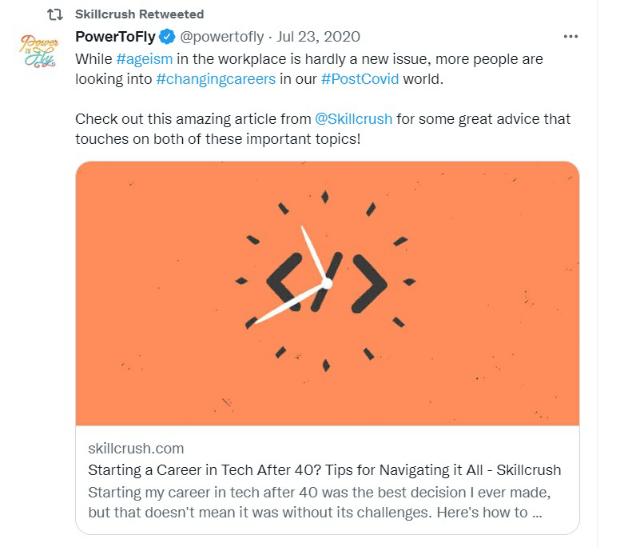
They know they produce premium content, and they know how to make it work great on social media.
Content Repurposing
Another way to use social media to boost your content (and vice versa) is through repurposing content. For instance, a 50-page white paper can easily be broken down into a whole series of articles that will then be shared on different social channels.
Sometimes brands even break down their articles into a series of social posts that tell a single story. This is a great practice because it uses the cliffhanger tactic from TV and soap operas in particular (and you know those people know what works). People see the first post, but the story isn’t finished. You can rest assured they will keep their eyes open for the next “episode.”
Some brands go even further and turn their written content into video. Scott’s Cheap Flights did this with their popular post on how to use Google Flights to find cheap tickets. They figured that such a topic would work even better in video format, and it did, receiving over 400,000 views on YouTube.
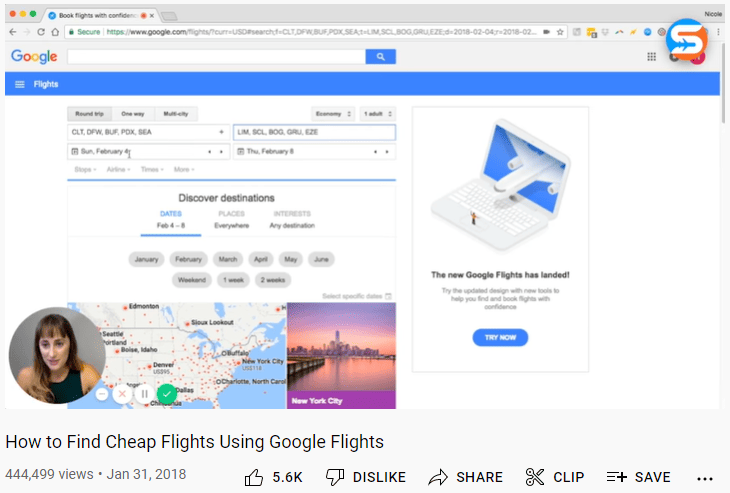
As you can see, they definitely didn’t spend a ton of money on making this video. They basically filmed one of their employees, Nicole, explaining their hack while showing people how to do it, and that’s it.
Chances are that some of your content could easily (and cheaply) be turned into another format that will elevate your brand’s social media presence without breaking the bank.
Build That Human Connection
Everyone understands that big brands (for the most part) stand for making money for their shareholders and little else. They are (once again, mostly) gargantuan money-making machines whose employees are expendable and whose customers are merely blips in the 6776345 daily graphs and pie charts.
As a smaller brand, social media gives you the perfect channel to show that your business is different – that it cares about the customers, the environment, the social issues, and its employees.
You already know that you are beating the Big Guys in this respect. So why not push this even harder?
And the best thing is that it does not require a big investment. Just be honest, let your employees tell your story, and get involved in the conversations that matter.
Customer apparel brand Realthread offers a great example. The vast majority of their Instagram account is about their employees, shedding light on the way they work and have fun. After a while, you get the feeling you know them personally. They are more than just a company selling T-shirts.
Source: https://www.instagram.com/p/CbxzBZbAoUJ/
Of course, there are industries, especially in the B2B arena, where it can be difficult to “humanize” your brand and, in fact, it might not even be the best choice for your brand. Still, it won’t hurt you to try.
Embrace UGC
UGC stands for user-generated content. And for a brand with a limited budget, UGC is often just what the doctor ordered.
For one, it is genuine, which goes a long way in terms of social proof. You are not telling people your product/service is great; your customers are.
It also shows that you are connected with your customers. You are building a community and not just trying to make a buck.
In addition to this, user-generated content saves you a lot of effort. You only need to curate UGC rather than create new content yourself. It can be a real money-saver if done right.
One brand that definitely does it right is Sola Wood Flowers, a US-based company that sells flowers made of sola wood. Their Facebook page is pretty much all about their customers – what they did with their products, how they spent their important dates, and so on.

They also organize different challenges for their customers who wish to show off their skills in arranging these special flowers.
While user-generated content will almost always work great, it can be difficult to inspire people to interact with your brand so that you have a constant stream of UGC. There are more than a few ways in which you can do this:
- Asking for user feedback
- Create a unique hashtag
- Launching contests on your chosen platforms
- Partnering up with influencers (be very careful)
- Asking your employees to help out
- Offering incentives to your customers
You will know best which of these (or which combinations) will work best for you.
If you want to learn more on this subject, there are plenty of guides out there on how you can entice people to contribute to your social media presence.
Conclusion
If your budget is limited, it will be difficult for you to match the social media presence of large brands with gigantic resources at their disposal. However, as you can see, there is still plenty you can do. Just approach it strategically, test everything, and don’t be afraid to experiment.
FAQ
What are the key benefits of elevating your brand’s social media presence?
Elevating your social media presence can increase brand awareness, engagement, customer loyalty, and drive traffic to your website.
How can you define a unique brand voice on social media?
Defining a unique brand voice involves identifying your brand’s personality, values, and tone, then consistently applying them in your social media content.
What role does content planning play in enhancing social media presence?
Content planning helps maintain a consistent posting schedule, ensuring a steady flow of engaging and relevant content for your audience.
Are there specific social media platforms that work best for certain industries?
Yes, certain platforms are more suited to specific industries. For example, Instagram may be ideal for visual brands, while LinkedIn is valuable for B2B companies.
How can you engage with your audience effectively on social media?
Effective engagement involves responding to comments, asking questions, running contests, and actively participating in discussions related to your industry.
What are some strategies for increasing social media followers and fans?
Strategies include running targeted ad campaigns, collaborating with influencers, and hosting giveaways to attract and retain followers.
Is it important to measure social media performance, and how can it be done?
Yes, measuring performance is crucial. Use social media analytics tools to track metrics like reach, engagement, click-through rates, and conversions.
How can user-generated content (UGC) enhance your social media presence?
UGC showcases real customers’ experiences with your brand, building trust and credibility among your audience.
What are the best practices for creating visually appealing social media content?
Use high-quality images, videos, and graphics, and adhere to platform-specific image size guidelines for a polished and professional look.
What is the role of social media advertising in boosting brand presence?
Social media advertising allows you to target specific demographics, expand your reach, and promote your brand to a wider audience effectively.
Improve your Marketing with the Power of AI
See how you can start with AI Marketing and reach your goals faster than ever before. Check out the Tips, Strategies, AI Tools, Masterclass, Courses, and Community. Unleash the true potential of your brand with the help of AI.